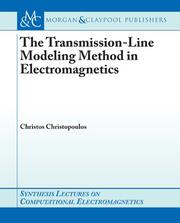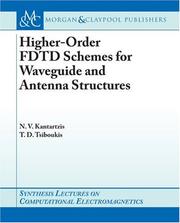| Listing 1 - 5 of 5 |
Sort by
|

ISBN: 1598290517 9781598290516 1598290509 9781598290509 Year: 2006 Publisher: San Rafael, Calif. (1537 Fourth Street, San Rafael, CA 94901 USA) Morgan & Claypool Publishers
Abstract | Keywords | Export | Availability | Bookmark
 Loading...
Loading...Choose an application
- Reference Manager
- EndNote
- RefWorks (Direct export to RefWorks)
This book presents the topic in electromagnetics known as transmission-line modeling or matrix method-TLM. While it is written for engineering students at graduate and advanced undergraduate levels, it is also highly suitable for specialists in computational electromagnetics working in industry, who wish to become familiar with the topic. The main method of implementation of TLM is via the time-domain differential equations, however, this can also be via the frequency-domain differential equations. The emphasis in this book is on the time-domain TLM. Physical concepts are emphasized here before embarking onto mathematical development in order to provide simple, straightforward suggestions for the development of models that can then be readily programmed for further computations. Sections with strong mathematical flavors have been included where there are clear methodological advantages forming the basis for developing practical modeling tools. The book can be read at different depths depending on the background of the reader, and can be consulted as and when the need arises.
Electric power transmission --- Electric lines --- Time-domain analysis. --- Electromagnetic theory --- Mathematical models. --- Mathematics. --- Light, Electromagnetic theory of --- Analysis, Time-domain --- Electricity --- Power lines --- Power transmission lines --- Powerlines --- Transmission lines --- Power transmission, Electric --- Distribution --- Transmission --- Computational electromagnetics. --- Matrix method-TLM. --- Time-domain methods. --- Transmission-line modeling. --- TLM. --- Electric fields --- Magnetic fields --- System analysis --- Electric power distribution --- Electric cables --- Electric power systems

ISBN: 1598290290 9781598290295 1598290282 9781598290288 Year: 2006 Publisher: San Rafael, Calif. (1537 Fourth Street, San Rafael, CA 94901 USA) Morgan & Claypool Publishers
Abstract | Keywords | Export | Availability | Bookmark
 Loading...
Loading...Choose an application
- Reference Manager
- EndNote
- RefWorks (Direct export to RefWorks)
This publication provides a comprehensive and systematically organized coverage of higher order finite-difference time-domain or FDTD schemes, demonstrating their potential role as a powerful modeling tool in computational electromagnetics. Special emphasis is drawn on the analysis of contemporary waveguide and antenna structures. Acknowledged as a significant breakthrough in the evolution of the original Yee's algorithm, the higher order FDTD operators remain the subject of an ongoing scientific research. Among their indisputable merits, one can distinguish the enhanced levels of accuracy even for coarse grid resolutions, the fast convergence rates, and the adjustable stability. In fact, as the fabrication standards of modern systems get stricter, it is apparent that such properties become very appealing for the accomplishment of elaborate and credible designs.
Electromagnetism --- Wave guides --- Antennas (Electronics) --- Time-domain analysis. --- Finite differences. --- Mathematical models. --- Differences, Finite --- Finite difference method --- Analysis, Time-domain --- Waveguides --- Electromagnetics --- Finite-difference time-domain methods. --- FDTD. --- Computational electromagnetics. --- Yee's algorithm. --- Waveguide and antenna structure and analysis. --- Electromagnetic modeling. --- Numerical analysis --- System analysis --- Electronic apparatus and appliances --- Electric conductors --- Electric waves --- Electromagnetic waves --- Gyrators --- Microwave transmission lines --- Radio --- Transducers --- Magnetic induction --- Magnetism --- Metamaterials --- Equipment and supplies
Book
Year: 2021 Publisher: Basel, Switzerland MDPI - Multidisciplinary Digital Publishing Institute
Abstract | Keywords | Export | Availability | Bookmark
 Loading...
Loading...Choose an application
- Reference Manager
- EndNote
- RefWorks (Direct export to RefWorks)
Like all branches of physics and engineering, electromagnetics relies on mathematical methods for modeling, simulation, and design procedures in all of its aspects (radiation, propagation, scattering, imaging, etc.). Originally, rigorous analytical techniques were the only machinery available to produce any useful results. In the 1960s and 1970s, emphasis was placed on asymptotic techniques, which produced approximations of the fields for very high frequencies when closed-form solutions were not feasible. Later, when computers demonstrated explosive progress, numerical techniques were utilized to develop approximate results of controllable accuracy for arbitrary geometries. In this Special Issue, the most recent advances in the aforementioned approaches are presented to illustrate the state-of-the-art mathematical techniques in electromagnetics.
cubic-quartic Schrödinger equation --- cubic-quartic resonant Schrödinger equation --- parabolic law --- wave field transformation --- finite difference method --- Cole–Cole model --- Monte Carlo simulations --- percolation --- conductivity --- carbon nanotubes composite --- optical parametric amplification --- non-linear wave mixing --- micro-resonator --- optimization --- MRI system --- birdcage coil --- birdcage configurations --- coil capacitance --- analytical solution --- equivalent circuit modelling --- T-matrix theory --- 3D-EM simulation --- small volume RF coil --- method of auxiliary sources (MAS) --- electromagnetic scattering --- wedge --- numerical methods --- accuracy --- coil gun --- reluctance --- electromagnetic launcher --- mechatronics --- electronics --- mechanics --- simulation --- RoboCup --- magnetic field strength --- magnetic flux density --- magnetic potential --- current density --- power transmission line --- electromagnetic modelling --- integral formulation --- skin effect --- thin shell approach --- mutual inductance --- finite element method --- partial element equivalent circuit method --- magnetite nanoparticles --- Mie scattering theory --- near infrared laser --- photothermal therapy --- bioheat transfer --- diffusion approximation --- Arrhenius integral --- breast cancer --- air-core pulsed alternator --- electromagnetic rail launcher --- coupled analysis --- computational electromagnetics --- integral formulations --- n/a --- cubic-quartic Schrödinger equation --- cubic-quartic resonant Schrödinger equation --- Cole-Cole model
Book
Year: 2021 Publisher: Basel, Switzerland MDPI - Multidisciplinary Digital Publishing Institute
Abstract | Keywords | Export | Availability | Bookmark
 Loading...
Loading...Choose an application
- Reference Manager
- EndNote
- RefWorks (Direct export to RefWorks)
Like all branches of physics and engineering, electromagnetics relies on mathematical methods for modeling, simulation, and design procedures in all of its aspects (radiation, propagation, scattering, imaging, etc.). Originally, rigorous analytical techniques were the only machinery available to produce any useful results. In the 1960s and 1970s, emphasis was placed on asymptotic techniques, which produced approximations of the fields for very high frequencies when closed-form solutions were not feasible. Later, when computers demonstrated explosive progress, numerical techniques were utilized to develop approximate results of controllable accuracy for arbitrary geometries. In this Special Issue, the most recent advances in the aforementioned approaches are presented to illustrate the state-of-the-art mathematical techniques in electromagnetics.
History of engineering & technology --- cubic-quartic Schrödinger equation --- cubic-quartic resonant Schrödinger equation --- parabolic law --- wave field transformation --- finite difference method --- Cole-Cole model --- Monte Carlo simulations --- percolation --- conductivity --- carbon nanotubes composite --- optical parametric amplification --- non-linear wave mixing --- micro-resonator --- optimization --- MRI system --- birdcage coil --- birdcage configurations --- coil capacitance --- analytical solution --- equivalent circuit modelling --- T-matrix theory --- 3D-EM simulation --- small volume RF coil --- method of auxiliary sources (MAS) --- electromagnetic scattering --- wedge --- numerical methods --- accuracy --- coil gun --- reluctance --- electromagnetic launcher --- mechatronics --- electronics --- mechanics --- simulation --- RoboCup --- magnetic field strength --- magnetic flux density --- magnetic potential --- current density --- power transmission line --- electromagnetic modelling --- integral formulation --- skin effect --- thin shell approach --- mutual inductance --- finite element method --- partial element equivalent circuit method --- magnetite nanoparticles --- Mie scattering theory --- near infrared laser --- photothermal therapy --- bioheat transfer --- diffusion approximation --- Arrhenius integral --- breast cancer --- air-core pulsed alternator --- electromagnetic rail launcher --- coupled analysis --- computational electromagnetics --- integral formulations --- cubic-quartic Schrödinger equation --- cubic-quartic resonant Schrödinger equation --- parabolic law --- wave field transformation --- finite difference method --- Cole-Cole model --- Monte Carlo simulations --- percolation --- conductivity --- carbon nanotubes composite --- optical parametric amplification --- non-linear wave mixing --- micro-resonator --- optimization --- MRI system --- birdcage coil --- birdcage configurations --- coil capacitance --- analytical solution --- equivalent circuit modelling --- T-matrix theory --- 3D-EM simulation --- small volume RF coil --- method of auxiliary sources (MAS) --- electromagnetic scattering --- wedge --- numerical methods --- accuracy --- coil gun --- reluctance --- electromagnetic launcher --- mechatronics --- electronics --- mechanics --- simulation --- RoboCup --- magnetic field strength --- magnetic flux density --- magnetic potential --- current density --- power transmission line --- electromagnetic modelling --- integral formulation --- skin effect --- thin shell approach --- mutual inductance --- finite element method --- partial element equivalent circuit method --- magnetite nanoparticles --- Mie scattering theory --- near infrared laser --- photothermal therapy --- bioheat transfer --- diffusion approximation --- Arrhenius integral --- breast cancer --- air-core pulsed alternator --- electromagnetic rail launcher --- coupled analysis --- computational electromagnetics --- integral formulations
Book
Year: 2021 Publisher: Basel, Switzerland MDPI - Multidisciplinary Digital Publishing Institute
Abstract | Keywords | Export | Availability | Bookmark
 Loading...
Loading...Choose an application
- Reference Manager
- EndNote
- RefWorks (Direct export to RefWorks)
Like all branches of physics and engineering, electromagnetics relies on mathematical methods for modeling, simulation, and design procedures in all of its aspects (radiation, propagation, scattering, imaging, etc.). Originally, rigorous analytical techniques were the only machinery available to produce any useful results. In the 1960s and 1970s, emphasis was placed on asymptotic techniques, which produced approximations of the fields for very high frequencies when closed-form solutions were not feasible. Later, when computers demonstrated explosive progress, numerical techniques were utilized to develop approximate results of controllable accuracy for arbitrary geometries. In this Special Issue, the most recent advances in the aforementioned approaches are presented to illustrate the state-of-the-art mathematical techniques in electromagnetics.
History of engineering & technology --- cubic-quartic Schrödinger equation --- cubic-quartic resonant Schrödinger equation --- parabolic law --- wave field transformation --- finite difference method --- Cole–Cole model --- Monte Carlo simulations --- percolation --- conductivity --- carbon nanotubes composite --- optical parametric amplification --- non-linear wave mixing --- micro-resonator --- optimization --- MRI system --- birdcage coil --- birdcage configurations --- coil capacitance --- analytical solution --- equivalent circuit modelling --- T-matrix theory --- 3D-EM simulation --- small volume RF coil --- method of auxiliary sources (MAS) --- electromagnetic scattering --- wedge --- numerical methods --- accuracy --- coil gun --- reluctance --- electromagnetic launcher --- mechatronics --- electronics --- mechanics --- simulation --- RoboCup --- magnetic field strength --- magnetic flux density --- magnetic potential --- current density --- power transmission line --- electromagnetic modelling --- integral formulation --- skin effect --- thin shell approach --- mutual inductance --- finite element method --- partial element equivalent circuit method --- magnetite nanoparticles --- Mie scattering theory --- near infrared laser --- photothermal therapy --- bioheat transfer --- diffusion approximation --- Arrhenius integral --- breast cancer --- air-core pulsed alternator --- electromagnetic rail launcher --- coupled analysis --- computational electromagnetics --- integral formulations --- n/a --- cubic-quartic Schrödinger equation --- cubic-quartic resonant Schrödinger equation --- Cole-Cole model
| Listing 1 - 5 of 5 |
Sort by
|

 Search
Search Feedback
Feedback About UniCat
About UniCat  Help
Help News
News